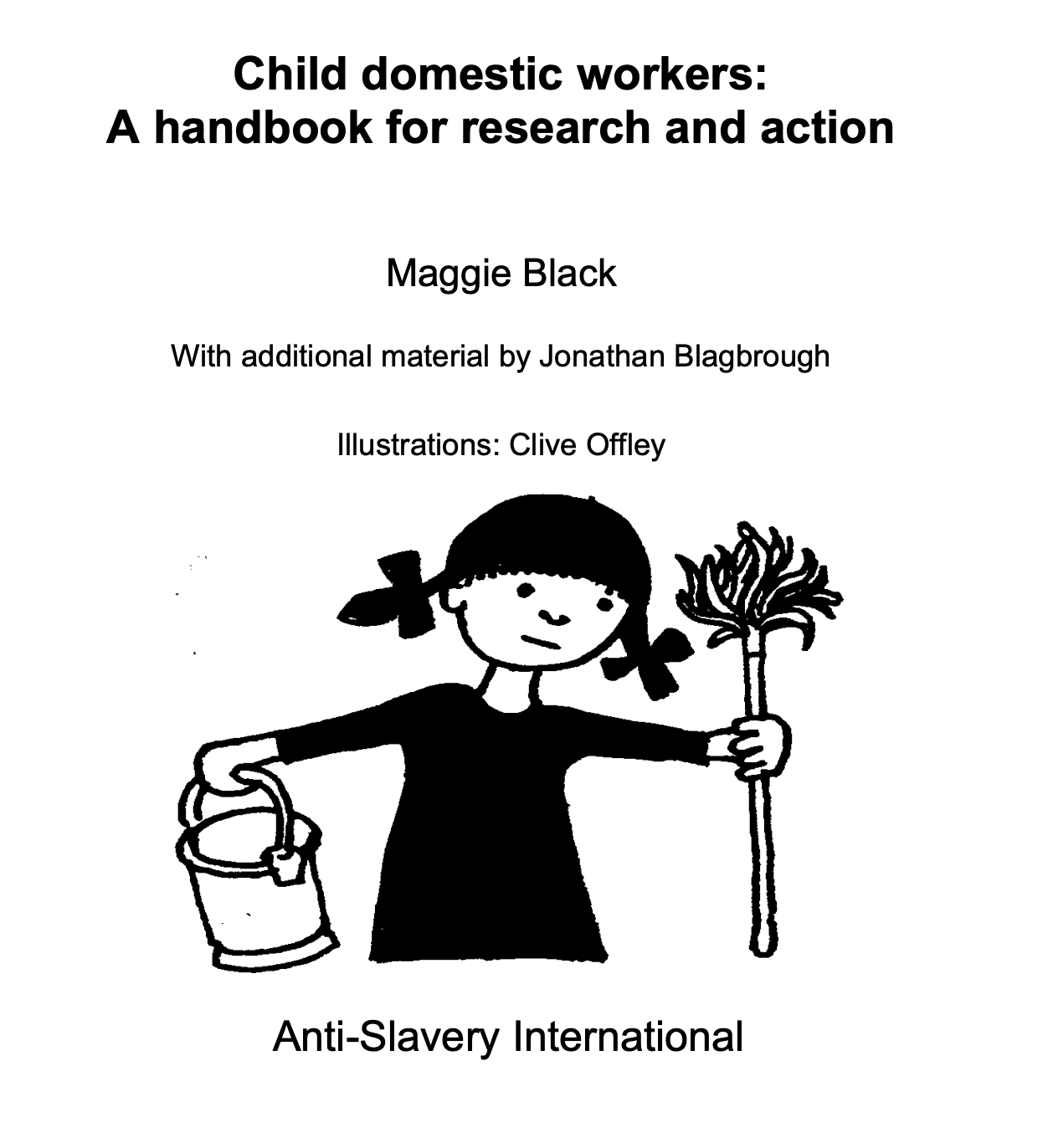
Child domestic workers: A handbook for research and action
The occupations in which children are most often found form part of the informal and frequently ‘invisible’ work-place. They are in open-air locations such as the street, the market, the shopping mall; on remote farms and plantations; in guest-houses and bars; in private households; and in back-room workshops. All these are outside the normal reach of labour controls.
More detailed and reliable information on the impact of work on children is needed to inform growing public concern about the issue. Methods of research need to be specially developed which take account of the wide variety of jobs undertaken by children, and of the difficulties in reaching them in certain settings — such as when they are employed within the households of others.
Anti-Slavery International (ASI) first became actively interested in the situation of children in domestic work during the early 1990s. ASI’s interest stemmed not only from its concern with exploitative child labour generally, but from the ways in which children are placed in such work — their ‘terms of employment’. The United Nations (UN) Supplementary Convention on the Abolition of Slavery, the Slave Trade, and Institutions and Practices Similar to Slavery (1956) defines the following practices as servitude, a form of slavery: ‘Any institution or practice whereby a child or young person under the age of 18 years is delivered by either or both of his natural parents or by his guardian to another person, whether for reward or not, with a view to the exploitation of the child or young person or of his labour.’ This precisely describes ASI’s concern with the way in which children typically enter domestic work.
Not only the contractual basis of child domestic labour but many of its practical characteristics have features akin to slavery. A child employed in a private household may be unpaid; be expected to work around the clock without set hours or time off; be virtually imprisoned and treated as the chattel of the employer. In the 1993 Report of the ILO’s Committee of Experts on the Application of the Conventions and Recommendations, the Committee commented on the situation of restaveks (child domestic workers) in Haiti in relation to one of the ILO’s most important labour standards — Convention No.29 Concerning Forced or Compulsory Labour (1930). The Committee noted the domestic worker’s separation from her home and family, the threat of physical and sexual abuse, the long hours, the exploitative conditions, and the humiliation she must endure.
In many cultures children are still regarded as totally under the control of parents; the idea that they have independent ‘rights’ of their own is alien. In such cultures it is common for employers of child domestics to be seen as parent substitutes. The situation of child servitude is, in these circumstances, regarded as natural, or at least acceptable. Only recently, mainly as an outcome of debates inspired by the UN Convention on the Rights of the Child, have non-governmental organisations (NGOs) in some countries of the South begun to challenge this perspective.
ASI, in taking forward the issue of child domestic workers, has been aware that it would be inappropriate to arouse attention internationally to their situation unless it does so in tandem with organisations in the countries where children are commonly employed as domestic workers. It was also thought irresponsible to mount an international advocacy campaign on an issue about which little data was available. Although domestic service is known to be one of the most widespread forms of child employment in the world, very little research has been done into it and there is limited reliable information on which to base campaigns.
ASI therefore adopted a policy of trying to identify NGOs which were interested in the issue, and encouraging them to undertake research. In 1993, ASI published a paper entitled: In search of a workable methodology for analysing the situation of child domestic workers. Subsequently, three research studies commissioned by ASI were undertaken drawing upon this methodology, in Togo, Bangladesh and Indonesia. Other NGOs and research institutions have also used it as a resource.
This handbook for researchers therefore takes forward a process in which ASI has been involved for some time. During that period, the International Programme on the Elimination of Child Labour (IPEC) of the ILO has become a close collaborator. UNICEF too has expressed support.
In January 1996, at the invitation of ASI and with IPEC support, a seminar was convened of researchers into child domestic work from all over the world. The 13 practitioner participants came from Bangladesh, Guatemala, Haiti, Indonesia, Kenya, Nepal, Philippines, Senegal and Togo. Representatives of IPEC, Save the Children Fund (UK) and Rädda Barnen (Sweden) also took part. The seminar’s purpose was to gain insights from the participants’ research experiences for the development of the research guidelines contained in this handbook.
Not only are the experiences and views of the seminar participants reflected here; so is the tenor of the meeting — that something simple and practical is needed. The handbook, therefore, offers a more practical approach to research, with useful insights for practitioners at different levels of technical competence. Hopefully, it will also inspire other child labour NGOs to enter the field, along with workers’ and employers’ organisations and relevant government departments. Much still needs to be done to repair the paucity of solid information concerning children working in people’s homes.
Read more here.
